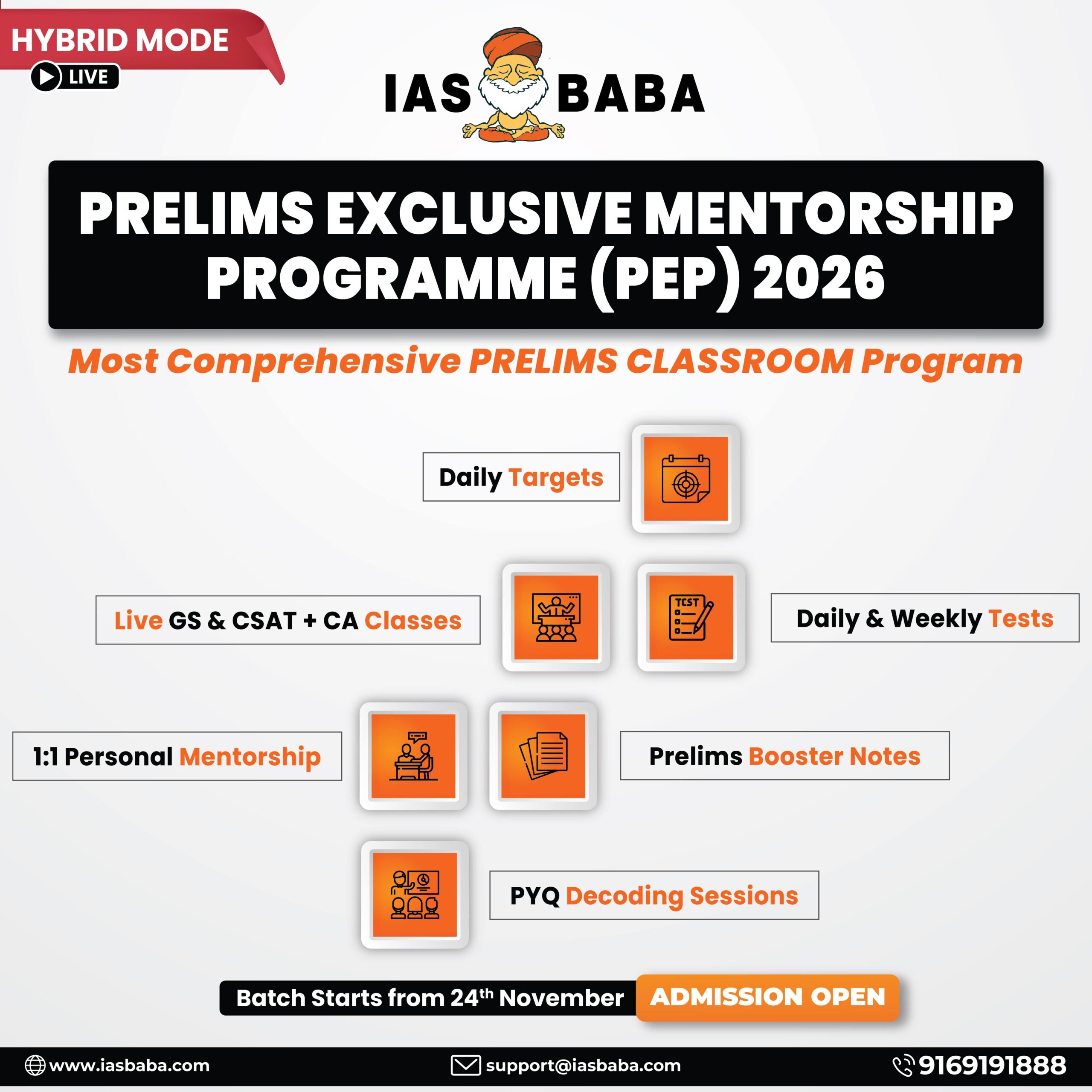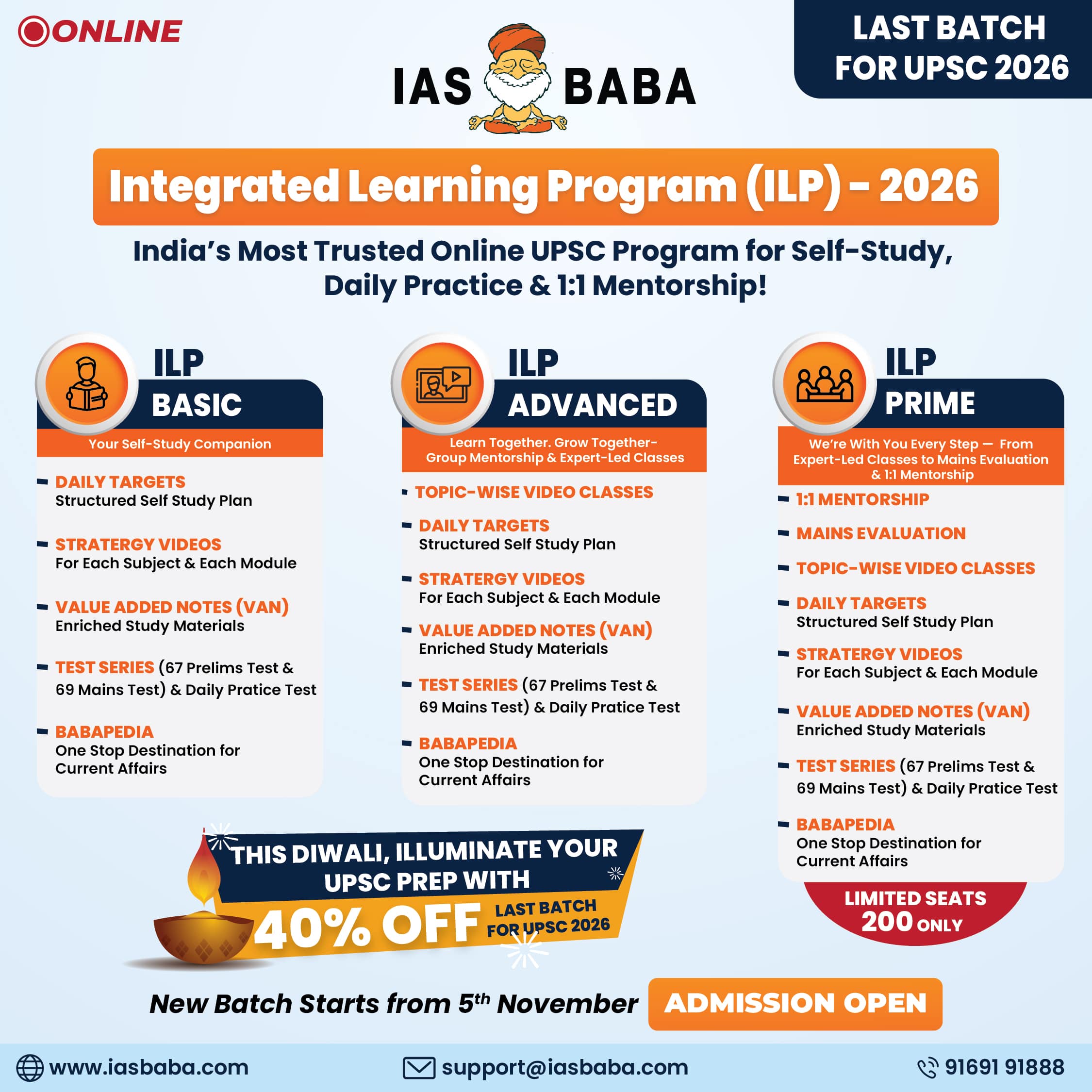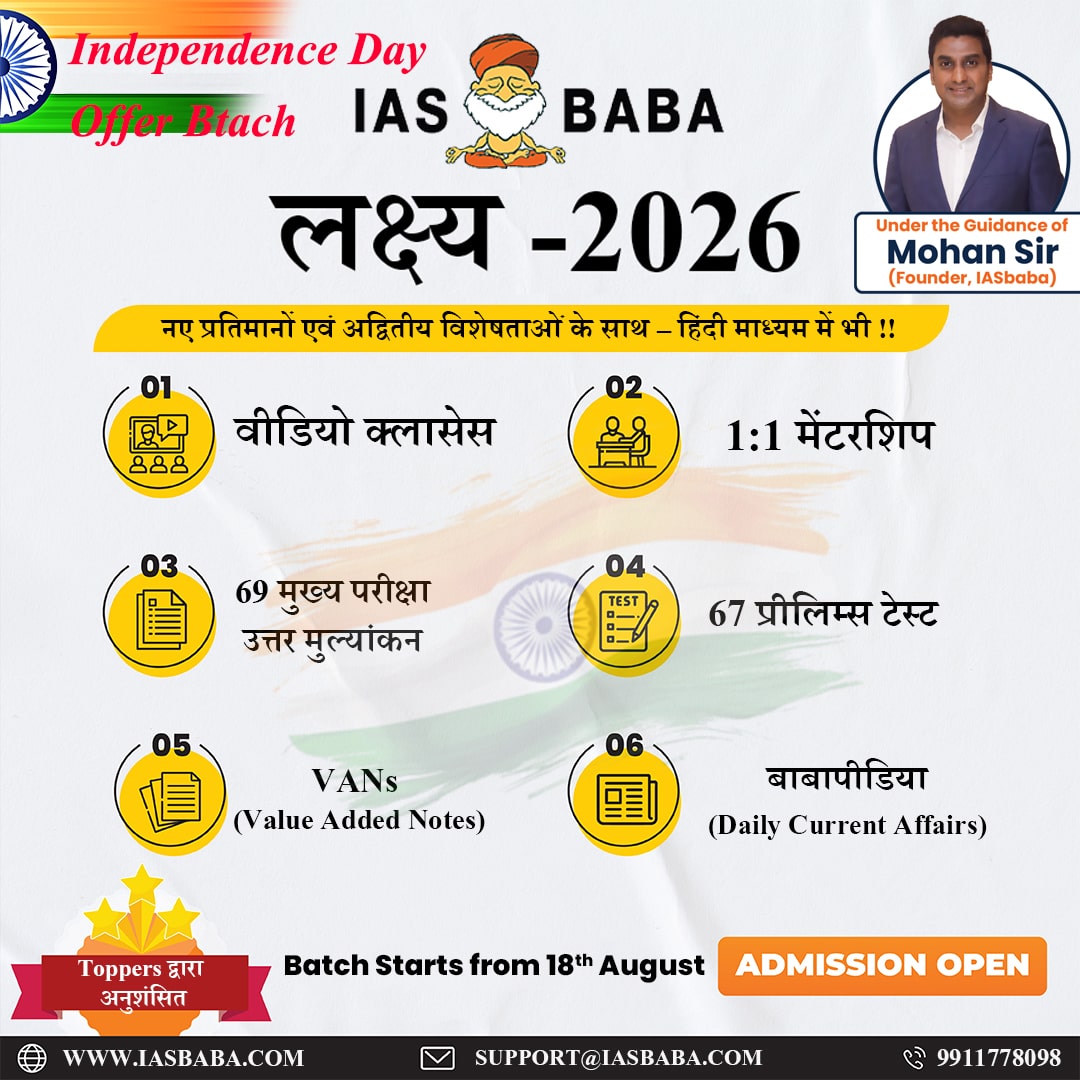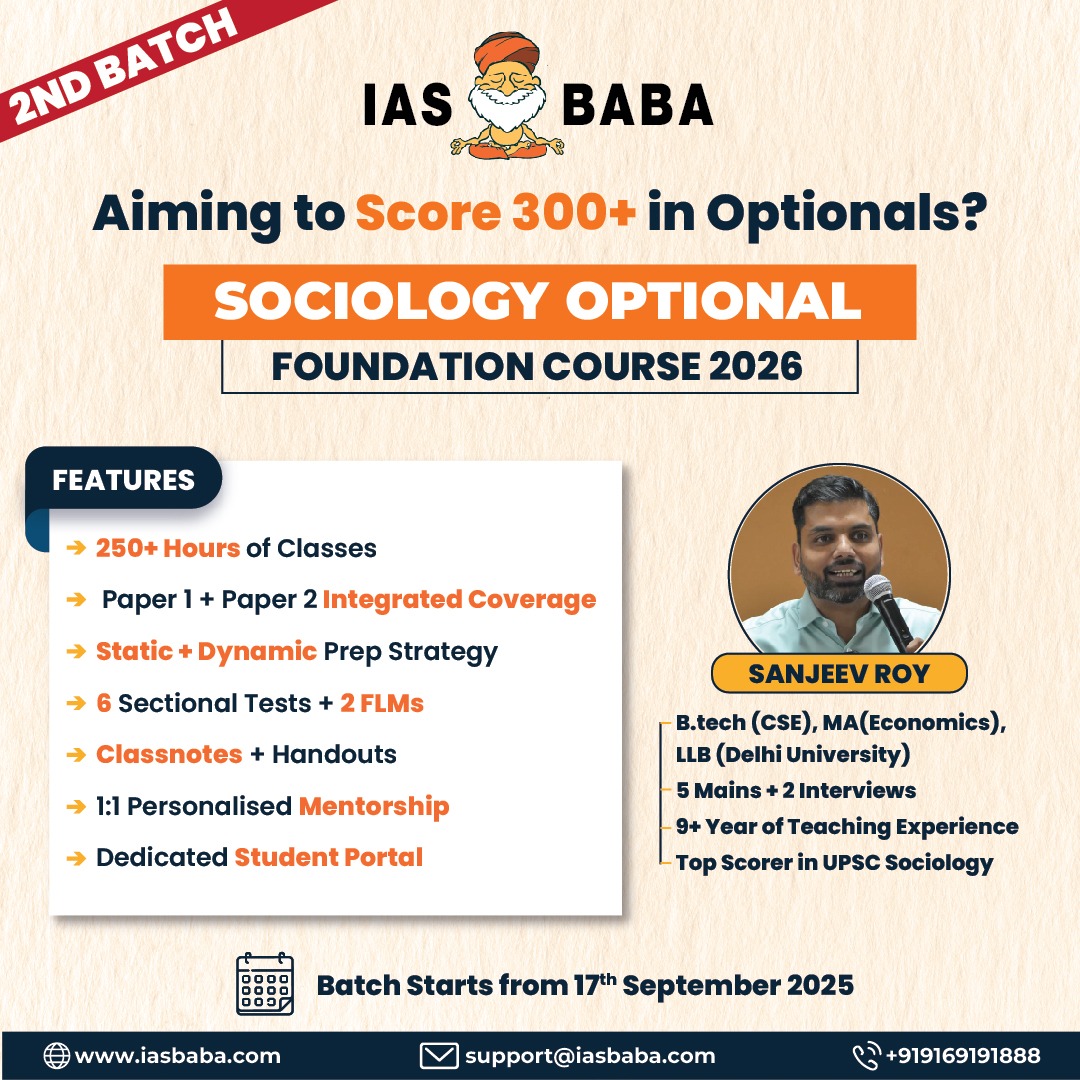IASbaba's Daily Current Affairs Analysis
Archives
(PRELIMS Focus)
Category: ECONOMICS
Context: The recent developments in the Bhushan Power and Steel Ltd. case have reignited concerns around the finality of resolution outcomes and the predictability of the framework.
Learning Corner:
Insolvency and Bankruptcy Code (IBC), 2016
The Insolvency and Bankruptcy Code (IBC), 2016 is India’s landmark legislation aimed at consolidating and streamlining the insolvency resolution process for individuals, companies, and partnership firms in a time-bound manner.
Objectives:
- To ensure time-bound resolution of insolvency and bankruptcy cases (within 330 days).
- To maximize the value of assets of insolvent persons.
- To promote entrepreneurship and availability of credit.
- To balance the interests of all stakeholders, including creditors, debtors, and employees.
- To improve India’s ease of doing business ranking and promote credit discipline.
Key Features:
- Single framework for insolvency and bankruptcy covering individuals, companies, and LLPs.
- Establishes institutional mechanisms such as:
- Insolvency and Bankruptcy Board of India (IBBI) – regulatory body
- National Company Law Tribunal (NCLT) – adjudicating authority for corporates
- Debt Recovery Tribunal (DRT) – for individuals and partnership firms
- Resolution Professionals (RPs) – manage the resolution process
- Creditors can initiate the process on default of ₹1 crore or more (earlier ₹1 lakh).
- Control of the defaulting firm is transferred from management to creditors via Committee of Creditors (CoC).
Achievements:
- Helped reduce non-performing assets (NPAs) – e.g., NPA ratio declined from 11.2% (2018) to 2.8% (2024).
- Promoted credit discipline among borrowers.
- Recovered over ₹3.89 lakh crore by 2024.
- Enhanced investor confidence and improved business ecosystem.
Challenges:
- Delays in resolution beyond 330 days due to judicial backlog.
- Low recovery rates in recent years (around 28.6%).
- Inadequate infrastructure, valuation disputes, and multiple legal appeals.
- Lack of clear treatment for operational creditors and complex business models.
Conclusion:
The IBC is a transformative reform in India’s economic governance. While it has improved resolution efficiency and credit discipline, its effectiveness depends on judicial efficiency, legal clarity, and institutional capacity building.
Source : THE HINDU
Category: ECONOMICS
Context The Reserve Bank of India (RBI), in its June 2025 Monetary Policy Committee (MPC) meeting, announced two major steps to support economic growth and liquidity
Decoding Context:
- Repo Rate Cut: The RBI reduced the repo rate by 50 basis points (bps) to 5.5%, marking a cumulative reduction of 100 bps in recent months. This move is expected to lower borrowing costs across the economy, benefiting both retail and corporate borrowers through reduced loan EMIs and cheaper credit.
- CRR Reduction: The RBI also decided to cut the Cash Reserve Ratio (CRR) by 100 bps, from 4% to 3%, in four quarterly tranches starting September 2025. This phased reduction is projected to inject approximately ₹2.5 lakh crore of liquidity into the banking system, enabling banks to lend more and further easing interest rates for consumers and businesses.
These steps are aimed at boosting credit growth, encouraging spending, and supporting India’s GDP, which is projected at 6.5% for FY26. The inflation outlook for the year has also been revised downward to 3.7%. The RBI’s policy stance has shifted from ‘accommodative’ to ‘neutral’, providing flexibility for future monetary actions.
Learning Corner:
Bank Rates & Monetary Policy Tools – Quick Comparison Table
| Type of Rate | Definition | Duration | Collateral | Key Purpose/Usage | Important Notes |
|---|---|---|---|---|---|
| Bank Rate | Rate at which RBI lends long-term funds to banks | Long-term | No | Signals monetary policy stance | Higher bank rate → costlier loans → reduced liquidity |
| Repo Rate | Rate at which RBI lends short-term funds to banks against securities | Short-term | Government Securities | Main tool to control inflation & liquidity | Lower repo → cheaper loans → more investment & consumption |
| Reverse Repo Rate | Rate at which RBI borrows from banks using securities | Short-term | Government Securities | Used to absorb excess liquidity | Higher rate → banks park funds with RBI → reduced lending |
| Marginal Standing Facility (MSF) | Rate for emergency overnight borrowing from RBI | Overnight | Government Securities | For banks exceeding normal borrowing limits | MSF > Repo (by 25 bps) – emergency window |
| Standing Deposit Facility (SDF) | Facility to absorb excess liquidity without collateral | Variable | No | Primary tool for liquidity absorption (since 2022) | Replaced Reverse Repo for liquidity control |
| Call Money Rate | Rate of 1-day borrowing/lending in the interbank market | Intraday / Overnight | No | Indicates short-term liquidity conditions | Market-determined, highly volatile |
Monetary Policy Committee (MPC)
What is MPC?
The Monetary Policy Committee (MPC) is a statutory and institutional body constituted by the Reserve Bank of India (RBI) to determine the policy interest rate (repo rate) required to achieve the inflation target set by the Government of India.
Background
- Constituted under the RBI Act, 1934 (Amended in 2016).
- Introduced as part of the monetary policy framework agreement between the RBI and Government of India in 2015.
Objectives
- Maintain price stability (control inflation).
- Support economic growth.
- Ensure transparency and accountability in monetary policy decisions.
Composition of MPC
Total 6 members:
| Members | Appointed By |
|---|---|
| RBI Governor (Chairperson ex-officio) | RBI |
| RBI Deputy Governor (in charge of MPC) | RBI |
| One RBI official nominated by Central Board | RBI |
| 3 external members | Appointed by Government of India |
- The Governor has a casting vote in case of a tie.
- Members have a term of 4 years, not eligible for reappointment.
Functions of MPC
- Sets the repo rate (key policy rate).
- Reviews monetary policy bi-monthly (every two months).
- Publishes Monetary Policy Statements.
- Aims to keep CPI inflation at 4% (+/- 2%) as per the inflation targeting framework.
Significance
- Brings objectivity and independence to monetary policy.
- Helps in containing headline inflation.
- Balances growth and inflation trade-off through informed decision-making.
Source : THE HINDU
Category: INTERNATIONAL
Context : Indian Prime Minister Narendra Modi has accepted an invitation from Canadian Prime Minister Mark Carney to attend the G7 Summit in Kananaskis, Alberta.
Decoding Context
This development comes amid previously strained India-Canada relations following the 2023 controversy involving the killing of Sikh activist Hardeep Singh Nijjar.
In a phone call on June 6, the two leaders discussed the longstanding bilateral relationship, underlining strong people-to-people ties and significant commercial linkages. Both agreed to continue law enforcement cooperation and address security concerns.
Carney emphasized India’s global economic importance and its critical role in global supply chains as reasons for the invitation. The move is widely seen as a signal of improving ties, despite ongoing challenges.
Modi acknowledged the invitation on social media, highlighting shared democratic values and expressing hope for stronger cooperation between the two countries.
Learning Corner:
G7 – Group of Seven
Overview
The G7 is an intergovernmental political and economic forum of the world’s most advanced and industrialized democracies, formed to coordinate responses to global challenges—economic, security, climate, and more.
Current Members (7 Nations + EU Participation)
Canada, France, Germany, Italy, Japan, United Kingdom, United States
NOTE: European Union (EU): Participates but is not a formal member.
Historical Background
- Established in 1975 (initially G6; Canada joined in 1976 to form G7).
- Created in response to the oil crisis and global economic recession in the 1970s.
- Became the G8 with Russia in 1997 but reverted to G7 in 2014 after Russia’s annexation of Crimea.
Objectives and Role
| Objective | Description |
|---|---|
| Economic Coordination | Harmonize policies among major economies to foster global economic stability |
| Global Governance | Set the agenda on climate, health, digital taxation, development aid, etc. |
| Security & Geopolitics | Address issues like terrorism, nuclear proliferation, and war (e.g., Ukraine) |
| Humanitarian Support | Focus on food security, pandemic response, gender equality, education |
Annual G7 Summit
- Hosted annually by a rotating member country.
- Features participation of heads of state/government.
- Includes guest invitees from other countries (e.g., India) and organizations like UN, IMF, WTO.
Decisions are not legally binding but carry high political weight.
Recent Key Themes (2022–2025)
| Year | Host Country | Major Agenda Themes |
|---|---|---|
| 2022 | Germany | Climate protection, global health, food security, Ukraine |
| 2023 | Japan | Economic resilience, AI governance, nuclear disarmament |
| 2024 | Italy | Africa partnerships, climate financing, energy security |
| 2025 | Canada | Global supply chains, democratic resilience, tech ethics |
Criticism of G7
- Seen as elitist and non-representative of emerging economies.
- Limited enforcement power — recommendations are not binding.
- Overshadowed by G20 in global economic matters due to broader representation.
India–Canada Relations
Overview
India and Canada share historically cordial relations based on democratic values, multiculturalism, people-to-people ties, education, and trade. However, the relationship has witnessed periodic strains, especially on issues related to Khalistani separatism.
Key Dimensions of Bilateral Relations
- Political Relations
- Diplomatic relations established in 1947.
- Periodic engagements at bilateral and multilateral forums (UN, G20, Commonwealth).
- Relations have been impacted by Canada’s stance on internal Indian matters, including Khalistan extremism.
- Economic & Trade Relations
- Bilateral trade (2023–24): ~USD 10 billion.
- Canada is a major source of potash, pulses, and energy products.
- India exports pharmaceuticals, textiles, engineering goods.
- Ongoing negotiations for a Comprehensive Economic Partnership Agreement (CEPA).
- People-to-People Ties
- Over 1.8 million Indo-Canadians (~5% of Canada’s population).
- India is the largest source of international students in Canada.
- Strong diaspora influence on bilateral ties and politics.
- Energy & Technology Cooperation
- Collaboration in civil nuclear energy under the 2010 nuclear cooperation agreement.
- Joint initiatives in clean energy, AI, climate action, and innovation.
Recent Issues & Strains
- Khalistan issue and pro-separatist activities in Canada.
- Diplomatic tensions in 2023 following Canadian allegations regarding the killing of Sikh activist Hardeep Singh Nijjar.
- Strained intelligence and security cooperation due to trust deficit.
Way Forward
- Strengthen counter-terror cooperation and avoid politicization of diaspora.
- Focus on education, clean tech, and economic partnerships.
- Build mutual trust through high-level visits and track-II diplomacy.
Source: THE HINDU
Category: CULTURE
Context : 800-Year-Old Shiva Temple Unearthed near Madurai
Overview
- An 800-year-old Shiva temple has been discovered near Madurai, Tamil Nadu.
- The structure dates back to the reign of Pandya king Maravarman Sundarapandian I (early 13th century CE).
Historical Significance
- The temple reflects Pandya-style architecture, known for its intricate stone work and structural temples.
- Inscriptions found on the site may offer details on:
- Land grants and endowments
- Temple administration
- Taxation systems under the Pandya dynasty
Role of Community & Experts
- The temple was partially buried and lay in neglect for centuries.
- Local villagers and archaeologists played a key role in unearthing the temple.
- Experts believe the find could reshape understanding of medieval South Indian temple networks.
Pandya Dynasty Context
- One of the three ancient Tamil dynasties (alongside Cholas and Cheras).
- Known for promoting Shaivism, Tamil culture, and temple patronage.
- Maravarman Sundarapandian I was a notable ruler who expanded the Pandya realm and supported temple construction.
Learning Corner:
Temple Architecture in India
- Definition & Importance
- Temple architecture refers to the style and structure of Hindu temples built over centuries, reflecting religious, cultural, and regional diversity.
- Temples were not just places of worship but also centers of art, culture, and community life.
- Major Styles of Temple Architecture
| Style | Region | Key Features | Examples |
|---|---|---|---|
| Nagara | Northern India | Curvilinear shikhara (spire), no boundary walls, multiple towers | Kandariya Mahadev (Khajuraho), Lingaraja (Odisha) |
| Dravida | Southern India | Pyramid-shaped vimana (tower), enclosed courtyard, large gopurams (gateway towers) | Brihadeeswarar Temple (Thanjavur), Meenakshi Temple (Madurai) |
| Vesara | Deccan region (Central-South) | Combination of Nagara and Dravida features, intricate carvings | Temples at Pattadakal, Badami |
- Basic Components of a Hindu Temple
- Garbhagriha (Sanctum sanctorum): The innermost chamber housing the deity’s idol.
- Mandapa: Pillared hall or pavilion where devotees gather.
- Shikhara / Vimana: The rising tower above the sanctum.
- Pradakshina Patha: Circumambulatory path around the sanctum.
- Gopuram: Monumental entrance tower (mainly in Dravida style).
- Significance
- Reflects religious symbolism, cosmology, and Indian aesthetics.
- Temples were royal projects showcasing dynastic power and artistic patronage.
- Serve as records of history through inscriptions and sculptures.
Source : THE HINDU
Category: DEFENCE
Context : The Indian Navy is set to commission its first Anti-Submarine Warfare Shallow Water Craft (ASW-SWC), named INS Arnala, at Visakhapatnam
Details of Warship:
INS Arnala is the lead ship in a series of 16 vessels designed and built by Garden Reach Shipbuilders & Engineers (GRSE), Kolkata, in partnership with L&T Shipbuilders under a Public-Private Partnership model.
Key Features:
- Over 80% indigenous content, with systems integrated by major Indian defence firms and contributions from more than 55 MSMEs, boosting India’s self-reliance in defence manufacturing.
- Length of 77 meters and displacement over 1,490 tonnes, making it the largest Indian warship powered by a diesel engine–waterjet propulsion system.
- Designed for anti-submarine warfare, subsurface surveillance, search and rescue, and low-intensity maritime missions to enhance coastal defence.
- Named after the historic Arnala Fort off Maharashtra, symbolizing India’s maritime heritage.
- The crest features a stylized Auger Shell, symbolizing resilience and vigilance, with the motto “Arnave Shauryam” (Valour in the Ocean).
Strategic Importance:
INS Arnala will strengthen the Navy’s ability to detect and counter undersea threats in shallow coastal waters, crucial amid increasing submarine activity in the region.
Learning Corner:
Anti-Submarine Warfare Ships of India
- INS Kamorta-class (Project 28)
- India’s first indigenously designed and built stealth ASW corvettes.
- Equipped with advanced sonar systems, torpedoes, anti-submarine rockets, and anti-ship missiles.
- Key ships: INS Kamorta, INS Kadmatt, INS Kiltan, INS Kavaratti.
- Operate primarily in coastal and offshore areas to detect and neutralize submarines.
- INS Kora-class Corvettes
- Multi-role corvettes with strong ASW capabilities alongside surface warfare.
- Fitted with torpedoes, depth charges, and anti-submarine rocket launchers.
- Pondicherry-class (Kilo-class) Submarines
- Though submarines themselves, these also perform ASW roles by hunting enemy subs.
- Acquired from Russia, these diesel-electric submarines enhance underwater warfare.
- INS Shivalik-class Frigates
- Multi-role stealth frigates with strong ASW sensors and weapons.
- Equipped with towed array sonar, torpedoes, and rocket launchers for submarine hunting.
- Other ASW Assets
- Indian Navy operates various ASW helicopters (e.g., HAL Dhruv, Sea King) and maritime patrol aircraft (e.g., P-8I) for anti-submarine detection and engagement.
Source: THE HINDU
(MAINS Focus)
| Date: 7-06-2025 | Mainspedia | |
TOPIC: Water management in India: Source to Sea approach |
GS Paper III – Environment
GS Paper II – Governance |
|
| Introduction (Context)
India is grappling with a water crisis marked by pollution, scarcity, overexploitation, and fragmented governance. In light of growing scientific consensus and global commitments—such as the UN’s International Year of Glacier Preservation 2025—a Source-to-Sea (S2S) approach to water governance is emerging as a critical alternative to the current fragmented systems. |
||
| Different commitments for Water management |
|
|
| What is Source to Sea Approach? |
|
|
| Why needed? |
|
|
| Formalization of S2S approach |
|
|
| Challenges in India |
|
|
| Initiatives in India |
However, the Source-to-Sea approach has not yet found space in mainstream water policy planning. Two case studies currently under exploration in India show early signs of S2S uptake.
|
|
| Issues with current apporach |
|
|
| Value addition | SDGs related to water
|
|
| Way forward |
|
|
| Conclusion
India’s current water governance model, fragmented and jurisdictionally scattered, is ill-equipped to deal with the complex realities of the 21st-century water crisis. The Source-to-Sea (S2S) approach offers a timely and transformative pathway, recognizing the ecological unity from glaciers to oceans. By aligning scientific research, policy frameworks, and multi-tiered governance systems, India can ensure sustainable and resilient water systems that serve both people and nature. |
||
Mains Practice Question
Q India’s water crisis is not just about scarcity but about fragmented governance. In this context, discuss the significance of the Source-to-Sea (S2S) approach for water management in India. (250 words, 15 marks)
| Date: 7-06-2025 | Mainspedia | |
TOPIC: Food Safety |
GS Paper II – Governance | |
| Introduction (Context)
World Food Safety Day 2025, observed on June 7, highlights the theme “Food Safety: Science in Action”. It serves as an opportunity to reflect on India’s shift from basic anti-adulteration laws to a modern, science-based food safety framework led by the FSSAI. However, critical gaps remain in risk assessment, communication, and regulatory coherence. |
||
| India’s journey on Food safety |
|
|
| Why food safety is important? |
|
|
| Challenges |
Lack of India-Specific Data:
Poor Risk Communication:
Legacy Regulatory Problems, Example of MSG
Institutional Weaknesses:
|
|
| Value addition | Terminologies
Food Safety and Standards Act, 2006
|
|
| Way forward |
|
|
| Conclusion
India’s food safety framework has evolved into a modern, risk-based system backed by FSSAI’s leadership. However, the journey forward must be anchored in scientific evidence, clear communication, institutional competence, and public trust. Eliminating outdated regulations and strengthening India-specific research are essential to ensure that food safety is not just about compliance but about confidence and informed choices. |
||
Mains Practice Question
Q India’s food safety transformation has been significant but not without its gaps. Critically examine the role of FSSAI and suggest a roadmap for making India’s food safety framework more scientific, transparent, and citizen-friendly. (250 words, 15 marks)
Daily Practice MCQs
Today’s – Daily Practice MCQs’ will be updated in our “Daily Current Affairs Quiz” section on our website
Please click on the below link













